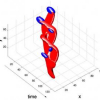Free Online Productivity Tools
i2Speak
i2Symbol
i2OCR
iTex2Img
iWeb2Print
iWeb2Shot
i2Type
iPdf2Split
iPdf2Merge
i2Bopomofo
i2Arabic
i2Style
i2Image
i2PDF
iLatex2Rtf
Sci2ools
ICPR
2004
IEEE
2004
IEEE
Velocity Adaptation of Space-Time Interest Points
The notion of local features in space-time has recently been proposed to capture and describe local events in video. When computing space-time descriptors, however, the result may strongly depend on the relative motion between the object and the camera. To compensate for this variation, we present a method that automatically adapts the features to the local velocity of the image pattern and, hence, results in a video representation that is stable with respect to different amounts of camera motion. Experimentally we show that the use of velocity adaptation substantially increases the repeatability of interest points as well as the stability of their associated descriptors. Moreover, for an application to human action recognition we demonstrate how velocityadapted features enable recognition of human actions in situations with unknown camera motion and complex, nonstationary backgrounds.
Computer Vision | Features Enable Recognition | ICPR 2004 | Space-time Descriptors | Unknown Camera Motion |
| Added | 09 Nov 2009 |
| Updated | 09 Nov 2009 |
| Type | Conference |
| Year | 2004 |
| Where | ICPR |
| Authors | Ivan Laptev, Tony Lindeberg |
Comments (0)

